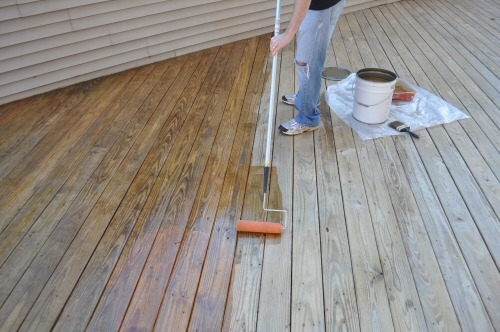
A wooden fence not only enhances your property’s aesthetic but also serves as a protective barrier against the elements. Over time, exposure to sun, rain, and humidity can deteriorate its appearance and structure. Applying a semi-transparent stain and sealer helps preserve the natural grain of the wood while offering essential protection against wear and tear.
This guide will walk you through everything you need to consider when choosing the right stain and sealer for your wood fence, including product types, application techniques, maintenance tips, and expert recommendations.
Why Choose a Semi-Transparent Stain and Sealer?
A semi-transparent stain and sealer offers the perfect balance between enhancing the wood’s natural beauty and providing long-lasting protection. Unlike solid stains or paint, which obscure the wood’s appearance, semi-transparent stains allow the natural grain to remain visible while adding subtle color.
Key Benefits:
✅ Preserves Natural Wood Texture – Unlike solid stains or opaque paints, semi-transparent stains highlight the natural grain. ✅ Moisture Protection – Prevents rotting, warping, and cracking by sealing the wood against excess water. ✅ UV Resistance – Minimizes discoloration and fading caused by exposure to sunlight. ✅ Longer Lifespan – Requires less maintenance compared to unstained wood while preventing peeling and flaking. ✅ Versatile Color Options – Available in multiple shades to complement different fence styles.
Factors to Consider When Selecting a Semi-Transparent Stain and Sealer
1. Understanding Your Wood Type
Different types of wood absorb stain differently. Knowing your fence’s material will help you select the most compatible stain and sealer:
- Cedar & Redwood: Naturally porous and absorb stain well. Light shades help maintain their warmth without excessive darkening.
- Pine & Spruce: Less porous, requiring stains with deeper penetration. Multiple coats may be necessary for a uniform finish.
- Pressure-Treated Wood: Requires an extended drying period before staining. Water-based stains work best for adherence.
2. Choosing Between Oil-Based and Water-Based Stains
Each stain type offers specific advantages:
✔️ Oil-Based Stains:
- Provide deep penetration into wood fibers, ensuring long-lasting protection.
- Offer superior water resistance.
- Take longer to dry but result in richer, more vibrant finishes.
✔️ Water-Based Stains:
- Dry faster and are more environmentally friendly with lower VOC emissions.
- Easier to clean (soap and water) and resistant to mildew growth.
- Ideal for humid climates where mildew resistance is essential.
3. Checking for Built-In Sealing Properties
Some stains include built-in sealers, eliminating the need for an additional protective layer. Look for stains that feature: 🔹 Waterproofing agents – Essential for repelling moisture. 🔹 Mildew inhibitors – Prevent mold growth in damp environments. 🔹 UV blockers – Protect against sun damage and discoloration.
4. Considering Climate Conditions
Your local climate significantly impacts the stain’s longevity and performance:
🌞 Hot/Dry Climates:
- Choose a stain with UV blockers to minimize fading.
- Opt for oil-based formulas for deeper penetration and protection.
🌧 Humid/Rainy Climates:
- Look for water-repellent stains to prevent moisture damage.
- Water-based stains are better suited for mildew prevention.
❄️ Cold/Snowy Climates:
- Select oil-based stains with sealing properties to prevent cracking during freeze-thaw cycles.
Top-Rated Semi-Transparent Stain and Sealer Brands
Here are recommended brands that offer high-quality semi-transparent stains and sealers for fences:
🔥 Behr Premium Semi-Transparent Stain & Sealer – Offers excellent durability and rich pigmentation. 🔥 Thompson’s WaterSeal Semi-Transparent Stain – Known for waterproofing and UV resistance. 🔥 Ready Seal Semi-Transparent Wood Stain – Easy to apply, requiring no back-brushing. 🔥 Cabot Semi-Transparent Stain – Ensures deep penetration for enhanced wood protection. 🔥 Defy Extreme Semi-Transparent Wood Stain – Water-based formula with excellent UV resistance.
Application Guide: How to Stain and Seal Your Fence Like a Professional
Proper application ensures a smooth, even finish while maximizing stain longevity.
Step 1: Preparing the Fence
- Clean the surface: Use a mild detergent or specialized wood cleaner to remove dirt, mildew, and debris.
- Allow the fence to dry completely: Wet wood will prevent proper stain absorption.
- Sand rough areas: Ensure a smooth, even application by eliminating splinters or imperfections.
Step 2: Choosing the Right Tools
🖌 Brush: Best for controlled application and deeper penetration. 🎨 Roller: Speeds up the process but may require back-brushing for consistency. 💨 Sprayer: Ideal for large fences but requires proper overspray management.
Step 3: Applying the Stain
✔ Work in sections, applying stain evenly. ✔ Follow the wood grain to ensure uniform absorption. ✔ Apply thin coats instead of thick layers to prevent blotching. ✔ Allow each coat to dry completely before adding additional layers.
Step 4: Sealing for Enhanced Protection
- If the stain does not contain built-in sealing properties, apply a clear topcoat sealer after staining.
- Reapply stain every 2–3 years, depending on exposure to the elements.
Maintenance Tips for Long-Term Protection
🛠 Inspect Annually: Look for signs of fading, mildew buildup, or wear. 🛠 Spot-Treat Problem Areas: Apply touch-ups as needed. 🛠 Keep the Fence Clean: Wash periodically to remove dirt and grime. 🛠 Position Sprinklers Away from the Fence: Minimizes excessive water exposure.
Final Thoughts
Selecting the right semi-transparent stain and sealer for your wood fence ensures long-lasting beauty and protection. By considering factors such as wood type, climate impact, stain composition, and application techniques, you can achieve an aesthetically pleasing, durable fence that withstands the elements.